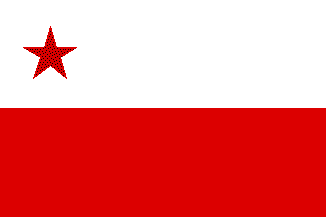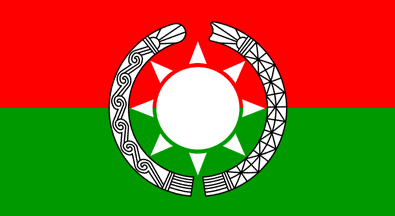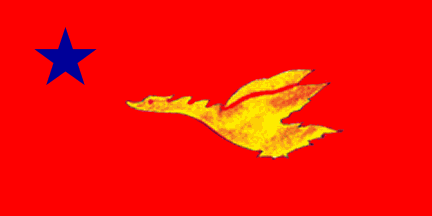 Mark Sensen, 1 June 1996, Crampton (1990)
Mark Sensen, 1 June 1996, Crampton (1990)
Last modified: 2007-07-28 by ian macdonald
Keywords: myanmar | burma | arakan | kachin | karenni | pa-o | lahu | wa | palaung | mon | karen | kawthoolei | chin | naga | rohingya |
Links: FOTW homepage |
search |
disclaimer and copyright |
write us |
mirrors
"Myanmar is a federal republic made of seven purely burmese divisions (Sagaing, Mandalay, Magwe, Pegu, Irrawaddy, Rangoon, Tenasserim) and seven states with non-burmese population (Kachin, Chan, Kayah, Karen, Mon, Arakan, Chin). National unity was not really achieved due to the diversity of populations. Burmese are mongoloid peoples speaking a language of the tibeto-burmese group, and represent 75% of the population, and up to 80% when including Arakans, who speak the same language but were more or less influenced by Islam, and Tenasserim Mo^ns, who speak a mo^n-khmer language and greatly influenced the Burmese civilization. Burmese are theravada buddhists.Chan (1,500,000 ?) are Tha, related to Siamese, and also theravada buddhists. They have preserved a feudal organization and dominate proto-indochinese minorities
Kachin of the mountains (450,000 ?) speak a tibeto-burmese language but were not influenced by Indians. They are animists or christians.
Chin tribes (400, 000?) are also of tibeto-burmese language but remain very primitive, and their dialects differ from one valley to the other.
Karen (2,000,000 ?) of the mountains speak a language close to burmese but are animists and partially christianised."[eun]
Ivan Sache, 16 Sep 1999
The flags shown here are probably those of organizations engaged in a struggle against the Myanmar government, as the designs do not coincide with the "official" flags of the states as illustrated in Burmese postage stamps of 1974.
The following tribes and peoples have reported flags:
See also:
 Mark Sensen, 1 June 1996, Crampton (1990)
Mark Sensen, 1 June 1996, Crampton (1990)
This flag (based on W.Crampton, if I remember right) corresponds to the National United Front of Arakan (NUFA), the principal military organization of the State of Arakan, with more than two hundred regular soldiers, the majority Arakanese with some Chin and Rohingas. The Arakanese people number some four million and live in the western hill country of Myanmar. The flag of the organization is horizontal white on red, and in the white part, near the shaft, a red star.
Reported as a flag of the Arakan State in a letter from George Pasch to Thanh-Tam Le dating from May 1982.
Than-Tam Le 09 June 1999
Concerning Arakan:
"Moslims of bengali origin already rebelled against the government between 1948 and 1954. The citizenship law of 1981 made a distinction between nation indigen ethnics (Chin, Kachin, Shan, Kayah, karen, Mon, Arakans) and those immigrated after 1824 (beginning of the first Angle-Burmese war who induced the annexation of Arakan). In 1982 appeared in Arakan refugees in Bangladesh the Rohingya Solidarity Organization (R. S. O.), which asked for the independence of North-Western. A new rebel organization, the Arakan Rohingya Islamic Front (A. R. I. F.) appeared in 1991." [eun]
Ivan Sache, 16 Sep 1999
The Kachin Independence Organization (KIO) counts more than five thousand regular soldiers. The Kachin people numbers some two million persons, who live in northernmost Myanmar.
Jaume Ollé, 13 August 1996.
"Kachinland (Kachin Independence Orgnization) - Burma". Similar to the above, but with stripes of equal height and smaller emblem. Identical to "Hainan".
Ivan Sache, 16 Sep 1999
" Kachin Independence Army (K.I.A.) signed under the direction of Brang Seng, former director of Kachin Baptist High School in Myitkyina, in March 1976 with the Burmese Communist Party [a pro-chinese rebellion movement opposed to the Burmese government] a cooperation agreement, which was considered as ideological by the Communists but only tactical by the Kachin. On 10 October 1980, a new agreement stated that the alliance was based on mutual respect. Therefore, China provided directly the Kachin with weapons in exchange of illegal exportations. The Kachin movement was reunified in 1981." [eun]
Ivan Sache, 16 Sep 1999
 image by
António Martins-Tuválkin, 14 June 2007
image by
António Martins-Tuválkin, 14 June 2007
Based on image at: http://www.kachinland.org/kno_2006/About_kno/constitution.htm
Quoting from the above site:
CONSTITUTION
Organization Name: It shall be called the Kachin National Organization or by its
acronym, KNO.
Organization Homeland: It is a statehood and shall be called Kachinland.
Organization Emblem: Historic ceremonial poles representing Male and Female with
a Harbinger Drum.
Organization Flag: Four colors with traditional meanings:
Evergreen: Truth and Faith
Red: Bravery and Sacrifice
Blue: Loyalty and Peace
White: Honesty and Integrity
Sun: Source of Life
Ceremonial Poles: Symbol of Cultural Heritage
Mikhail Revnivtsev, 13 June 2006
It is a red over green ~5:9 horizontal
bicolor with large white emblem overall. This consists of a
Namibian-style sun (i.e., disc surrounded by stubby triangle outwards for
rays) with eight rays surrounded bracket-like by two arching elements (the said
ceremonial poles?), these with black edging and lining. Both bottom ends of
these show a fringe-like pattern; the hoist side pole top end is convex while
the fly-side is convex, both are filled with a stylized sunrise/sunset motif.
The main patterns are unequal: The hoist side pole is filled with a wave-like
coiled motif repeating 6,5 times while the fly side pole is filled with six
radial cells stroked on their diagonals and pseudo-apothems.
António Martins-Tuválkin, 14 June 2007Karen
The national flag of Karen (Republic of Kawtholei) according Franciae Vexilla
#20/66, December 2000, by J. Renault & H. Calvarin.
Jaume Ollé, 25 January 2001
See also:
The Karenni Nation Progressive Party (KNPP) has 200 regular fighters (Kayaw, Kaya, Manamanaw, Shao, Pa-O and others). The Karenni number approximately 300,000.
An alternate version of the flag of the Karenni States is reported to have equal width stripes, red, white and blue, with a central motif in black consisting of a central 12-pointed star surrounded by four frogs in an inner circle and four fish in an outer circle.
Murray Menzies, Karenni Govt. South Pacific Regional Charge d'Affaires, 1 March 1998
In 'Franciae Vexillae' # 4/50 (January 1997), M. Corbic reports the history of the Karenni flag, as follows:
Recently the Minister of Foreign Affairs Mr. Abel Tweed and the South Pacific regional charge d'affairs sent me much documentation and I redrew the flag according to the official documentation. The flag is three horizontal stripes of red, white and blue, with the emblem in the center. Several times is reported the same flag but with the central stripe double wide. The official name of the country is the United Karenni independent States, but is abrreviated United States of Karenni. The states are Bawlake, Kyebogyi and Kantarawaddy. The emblem has four fish and four toad and a twelve pointed star.
Jaume Ollé, 15 June 1998
 image by Eugene Ipavec, 12 September 2006
image by Eugene Ipavec, 12 September 2006
An article in The Irrawaddy News Magazine from November 2005 shows the flags of
the Mon nation and of the Karenni National Progressive Party. The KNPP flag is
completely different from those above. Source:
http://www.irrawaddy.org/aviewer.asp?a=5171&z=102.
Valentin Poposki, 11 September 2006
See also:
"Lahu National Organization (Lahus) - Burma." Similar to above, but with stripes of equal height. I have found mention of Lahu tribes in Laos but not in Burma.
Ivan Sache, 16 Sep 1999
 Eugene Ipavec, 12 September 2006
Eugene Ipavec, 12 September 2006
Nickname: Flag of the Golden Drake Flying. The New Mon State Party (NMSP) has 3,000 regular fighters (mostly Mon). The Mon people number approximately one million.
Jaume Ollé, 15 August 1996
An article in The Irrawaddy News Magazine from November 2005 shows the flags of
the Mon nation and of the Karenni National Progressive Party. Source:
http://www.irrawaddy.org/aviewer.asp?a=5171&z=102.
Valentin Poposki, 11 September 2006
Reported as a flag of the Arakan State in a letter from George Pasch to Thanh-Tam Le dating from May 1982. The bird is probably a sheldrake.
Than-Tam Le 09 June 1999
"New Môns State Party (Môns) - Burma." Similar to the first one above but with different bird (flying drake represented in profile, in "cruising flight" position.) Ivan Sache, 16 Sep 1999
"The Môn ethnic group established in the past rich and powerful kingdoms in Burma and Thailand, but is nowadays a minority trying to preserve its identity, in spite of the fiction of a "Môn federate state' in Myanmar. At the end of the 70's, they were ca. 1,000,000 Môns in Myanmar and 60,000-100,000 of them in Thailand. The ethnic emblem is a species of duck, which represents the brahmanic 'hamsa' [the mount of God Brahma]. Môn language belongs to the Môn-Khmer family, with one of the oldest writing system in the area." [eun]
Ivan Sache, 16 Sep 1999
After the British-Burmese war, British troops evacuated the occupied regions of
Syriam, Rangoon Prome, etc... The Mon (called by the Burmese Talaing) were the
majority in Syriam, and expected the formation of a national state under British
protection. However they did not obtain it, and then, allied with the
Karen (that also expected a British protected state) revolted and proclaimed the
Kingdom of Talaing. Maong Sat, brother-in-law of the Burmese king, ethnic Mon
and governor of Syriam, was proclaimed king (1826). But Burmese troops occupied
the kingdom and supressed it in 1827.
Jaume Ollé,
30 June 2001
Franciae Vexilla reported another flag supposed
to be from Pegu, a Mon Kingdom in fact called Ramanyadesa (capital Pegu),
according to Norie and Hobbs, but Vexilologie
15 shows a similar flag attribued to Sanove. Perhaps is the flag hoisted by the
kingdom of Talaings (Mon) when was annexed to Britain in 1825/26 (Talaing
kingdom I believe that was the remain of the old Pegu kingdom, and was vassal of
Ava/Burma kings).
Jaume Ollé, 28 June 2001
See also:
Jaume Ollé, 14 August 1996.
"Surrender of the P.S.L.A. was effective in May 1991." [eun]Ivan Sache, 16 Sep 1999
Jaume Ollé, 14 August 1996
"Surrender of the Pa-Os was effective in April 1991." [eun]Ivan Sache, 16 Sep 1999
 image by Jaume Ollé, located by J. Patrick Fischer, 30 January
2006
image by Jaume Ollé, located by J. Patrick Fischer, 30 January
2006
Source: Catalan Wikipedia
A green flag with a small seal bearing an ornate pattern of white on brown. The reliability of this flag is unknown. [Ed.]
"Courrier International" #773, 25 August 2005, gives the translation of a paper
by Xiaoning originally published in "Waitan Huabao", Shangai (People's Republic
of China):
The United Wa State Army (USWA) is the biggest of the armed groups not
controlled by the government of Myanmar, in spite of the obsolescence of its
weapons. It has 20,000 professional soldiers and 40,000 civilian recruits. Its
leader Bao Yuxiang is considered by the American government as "the third leader
of a terrorist organization to be suppressed after Bin Laden and Saddam
Hussein". A reward of 3 million USD is offered for his capture. Bao, the sixth
of the eight children of the chief of a Wa tribe, founded with his elder son Bao
Yuyi and his uncle Bao Sanban an anti-government guerrilla movement. In the
1960s, he joined the Burmese Communist Party, then fighting the central
government.. In 1989, he left the Party and found his own army, coming to a
peace agreement with the ruling junta. With his 40,000 soldiers, he founded the
Autonomous Wa State and helped the army of Myanmar in its fight against Khun Sa,
the lord of the Golden Triangle (see Shan Army). After Khun Sa's fall in 1996,
Bao became the new lord of the Golden Triangle. In 2005, the government of the
Wa State announced that all the poppy cultures in the State should be eradicated
and that sowing of new fields in autumn 2005 will be strictly prohibited.
Yuxiang claims he wants to transform the Wa State into a tourist region and
economic zone; he already owns the "Mayflower Myanmar Group", which controls the
biggest bank in Myanmar, and he owns all the shares of the Myanmar national
airline.
Ivan Sache, 1 May 2006